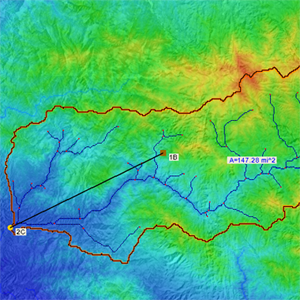We use cookies to make your experience better. To comply with the new e-Privacy directive, we need to ask for your consent to set the cookies. Learn more.
National Stream Statistics (NSS)
Develop Regional Regression Equations for Estimating Flood
Magnitude & Frequency of Ungaged Watersheds

Application:Regression-based
Hydrologic Modeling
Method:Regression-based single node
Model Type:1D
Developer:U.S. Geological Survey
Why NSS with WMS?
WMS provides a custom interface to the NSS model offering a simple way to set model parameters and a graphical user interface to run the model and visualize the results. Gather background data from a variety of sources from GIS to CAD and access online data from numerous databases of maps, images, elevation, land use, and soil data. WMS allows you to interact with models in true 3D taking advantage of optimized OpenGL graphics and to create photo-realistic renderings and animations for PowerPoint, print, and web presentations.
Try WMS Free for 14 Days >Purchase WMS with NSS >
NSS Description:
NSS contains all of the NFF functionality and equations as well as low flow and other probability equations.
WMS includes an interface to the National Flood Frequency Program (NFF). The NFF program is a compilation of all the current (as of September 2003) statewide and metropolitan area regression equations. The regression equations are a result of years of effort by the United States Geological Survey (USGS) to develop regional regression equations for estimating flood magnitude and frequency of ungaged watersheds. The USGS, in cooperation with the Federal Highway Administration and the Federal Emergency Management Agency compiled all the regression equations into a single database file. This database file is the basis of the NFF program, which can be used to guide the user through the input required to compute peak flows for different frequencies using the database of state by state regression equations.
The NFF interface in WMS provides a windows based, graphical user interface to the same database of regression equations. The entire program is run from a single dialog. Further, if a digital terrain model is available for the study area, all of the geometric parameters required for the regression equations are automatically supplied as the individual equations are specified. These parameters include area, slope, elevation, distances, and others.
The NFF equations are useful for estimating a peak flood discharge and typical flood hydrograph for a given recurrence interval of an unregulated rural or urban watershed. These techniques should be useful to engineers and hydrologists for planning and design purposes. A statewide summary, along with other technical information can be found in the USGS Water-Resources Investigations Report 94-4002.
